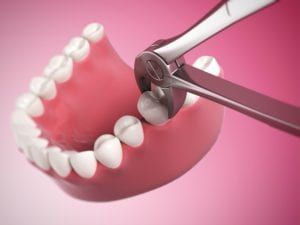Tooth extractions are a type of dental procedure that is performed when a tooth cannot be safely restored through other dental treatments. Extractions are also commonly performed on partially or fully impacted wisdom teeth. During an extraction, the affected tooth or teeth are removed from the mouth in order to preserve your overall oral health. Depending on your individual case, teeth can be removed one of two ways:
- The first way is through a simple extraction. Like the name suggests, a simple extraction easily removes the tooth in one piece through the use of specialized tools. Simple extractions are performed on teeth that have completely erupted and are intact.
- The second way is through a surgical extraction. A surgical extraction usually involves a small incision in the gums and breaking the tooth into smaller pieces before removing one piece at a time. This is because surgical extractions are performed on partially or completely impacted wisdom teeth, as well as teeth that are not able to be extracted in one piece. Breaking the tooth into smaller pieces actually reduces the trauma on the surrounding structures and helps the extraction site to heal better.
Did You Know?
Most dental offices are well-equipped to handle tooth extractions. This means that they can be performed in the office even though they are considered dental surgery. However, complicated cases may need to be referred out to an oral surgeon who specializes in extracting difficult teeth.
Frequently Asked Questions:
Am I a candidate for a tooth extraction?
Candidates for tooth extractions include those who have teeth that are:
- Severely damaged beyond repair
- Severely decayed
- Overcrowded due to a lack of space
- Partially or fully impacted under the gums
- Loose from gum disease
In order to know for sure if a tooth extraction is right for you, you will need to schedule an appointment with your Saratoga dentist so they can perform a dental exam and dental x-rays.
What happens during a tooth extraction?

During a tooth extraction, one of the two aforementioned methods will be used. This treatment plan will be discussed with you prior to your procedure during your pre-operative appointment so you know what to expect. As a general rule, all tooth extractions are performed with the use of both dental anesthetics and dental sedation. There are varying levels of dental sedation that may be used, and this will also be discussed prior to your procedure to determine what type of dental sedation would work best for you. Moderate dental sedation can make you feel relaxed and may allow you to fall into a light sleep, while deeper sedation can result in deeper levels of sleep. In some cases, patients report feeling pressure, while other patients have no memory of their procedure. Please be advised that the use of dental sedation means you are required to have a driver to take you home.
What happens after a tooth extraction?
After a tooth extraction, you will be monitored shortly in our office. As you start to come out of sedation, you may feel that your mouth is huge. This is partially due to the fact that your mouth will still be numb, as well as the fact that you will also have cotton rolls stuffed around the extraction sites to control any bleeding. Before you leave our office, you will be provided with post-operative instructions that contain detailed information about the recovery process and what to eat in the days following your extraction. Assuming there are no complications, you can expect to recover in about 7-10 days.

